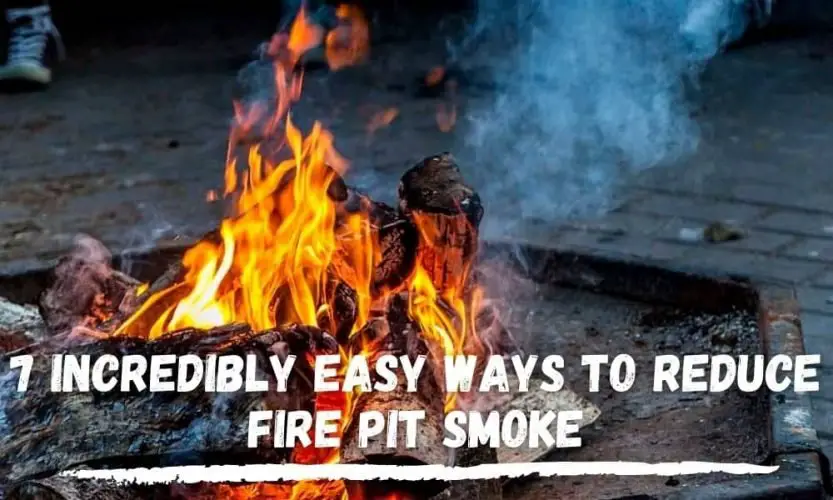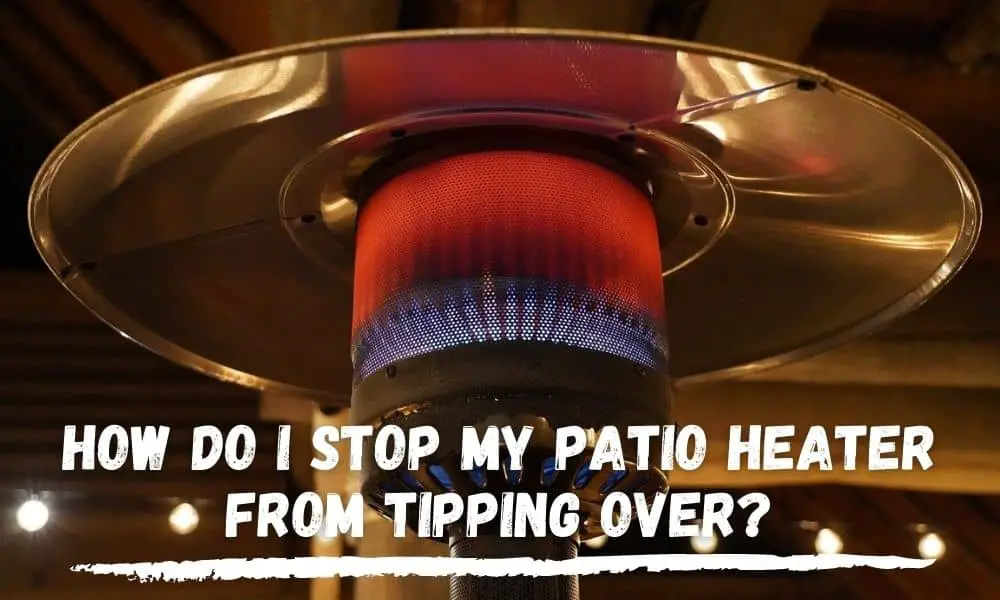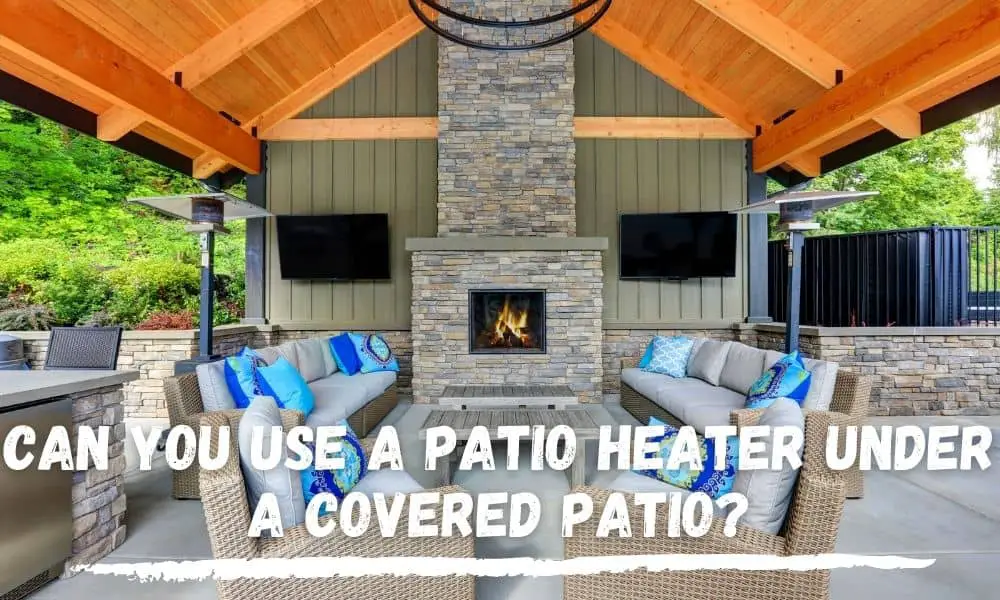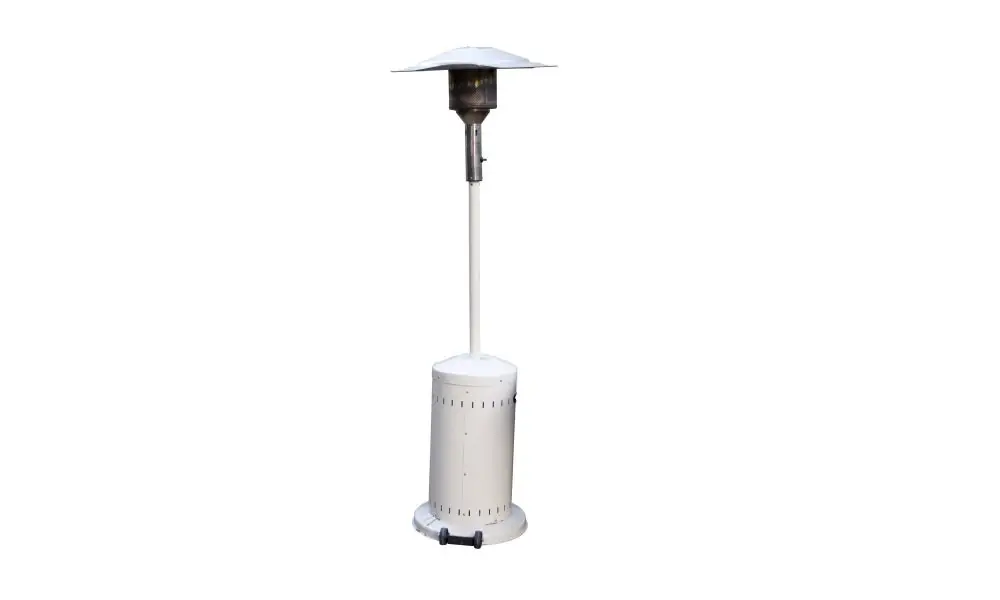Did you forget your windows open and had a heck of a time getting wood smoke from your backyard fire pit out of the house?

In this article, we are going to guide you on how to prevent excessive smoke. We will explore wood types, maintenance practices, smoke-reducing fire pits, and fuel arrangement techniques.
Whether your budget is tight or you can afford a new fire pit, there is something for all. Shall we?
Quick Navigation
- How Do I Stop My Fire Pit From Smoking?
- 1. Use Kiln-dried or Well-seasoned Wood
- 2. Use Wood Types that Don’t Naturally Produce Much Smoke
- 3. Using a Dakota Fire Pit for a Smokeless Fire
- 4. Using the Charcoal Method to Achieve a Smokeless Fire Fit
- 5. Using the Upside-down Design for a Smokeless Fire Pit
- 6. Using the Log Cabin Technique to Get a Smokeless Fire Pit
- 7. Using a Smokeless Fire Pit
- Firewood Arrangement Techniques to Get a Smokeless Fire Pit
- Keep Your Fire Pit Clean After Using It
- Frequently Asked Questions
- Conclusion
How Do I Stop My Fire Pit From Smoking?
1. Use Kiln-dried or Well-seasoned Wood
Well-dried wood produces low smoke amounts and performs better than improperly-dried wood.
Air-Dried(Seasoned) Wood
When you chop and stack your wood, go for hardwoods and not softwoods. In most cases, softwood is generally way smokier than hardwood.
Due to their compactness, hardwoods will take a longer time to season than softwoods. However, once properly dry, they burn for a more extended period and are hotter than softwoods.
Know the type of wood you are using and how long it takes to season it. Each type of hardwood will take a different amount of time to season. If you keep your wood sheltered from rainy conditions, you will take a shorter time to season it.
Consider bringing your wood out to the sun to dry and back in a shelter during rainy conditions and at night. You can take approximately a year to properly season your wood before using it.
You can use a moisture meter to determine the moisture content in your wood. A moisture level of 25% is alright but if you want the least smoke production or close to nothing, opt for wood with a moisture level below 20%.
Before purchasing dry wood from a dealer, ensure that you first determine their firewood’s type and moisture content.
Have your moisture meter with you during the wood delivery to confirm that they were telling you the truth.
You are going to pay the same amount irrespective of the seasoning quality. Therefore, you must make sure you are getting thoroughly dry wood.
Kiln-Dried Wood
Kiln-dried firewood is more costly than air-dried firewood, and its price can be up to 30% more. However, it is super dry hence ideal for smokeless fires. Kiln-dried wood stays in a kiln for two days at 250-degrees Fahrenheit.
You can immediately build a fire with kiln-dried firewood upon delivery. Since it has a low moisture content(below 20%), it produces little to no smoke at all.
Due to the dry temperatures, kiln-dried firewood does not have mold or insects on its surface. Thus, you can effortlessly store it in the house without worry. Besides, the hot temperatures ensure that wood pests like the Asian long-horned beetle and the emerald ash borer don’t move around.
If you want to get kiln-dried firewood, make sure to use it not long after purchase. This is because it will absorb moisture if you leave it for long; hence the original benefits will be lost.
Another alternative is to store kiln-dried firewood in your house. But that means that you need adequate space.
Whether using kiln-dried or air-dried firewood, ensure the moisture content is at most 25% to get the least smoke from your fire pit.
2. Use Wood Types that Don’t Naturally Produce Much Smoke
We now know that hardwoods will generally produce less smoke than softwoods if adequately seasoned.
However, not all hardwoods produce little smoke amounts in fire pits. We will cover the hardwoods that produce excessive smoke and softwoods as well.
a) Using Hardwoods for Firewood to Get a Smokeless Fire Pit
Due to their thick density, most hardwoods hold less water than softwoods. Excellent hardwoods that will produce less smoke in fire pits include;
- Oak
- Ash
- Hickory
- Maple
Hardwoods that will produce the most smoke include;
- Elm
- Poplar
- Eucalyptus
Despite the excessive wood smoke, they still produce a lot of heat and burn for a long time.
b) Using Softwood for Firewood
Softwood like pine, hemlock, spruce, cedar, fir might be abundant in your locality. Even though they are easily available, they are not the best woods for your firepit because they don’t minimize smoke.
They contain sap, which upon drying, leads to excessive smoke. If softwoods are the only alternative you can use in your fire pit, ensure they are properly seasoned. Don’t compromise the 25% moisture if you hope to get little smoke with softwoods.
3. Using a Dakota Fire Pit for a Smokeless Fire
To build a Dakota fire pit, you’ll require:
- Shovel
- Kindling
- Charcoal
To make the Dakota fire pit:
- Dig about one foot deep using your shovel. Your hole should be roughly cylindrical with a diameter similar to the height.
- Extend the bottom of your burn chamber until it forms a jug-like shape.
The importance of achieving a jug-like shape is:
- It offers more room to accommodate large wood pieces. Therefore, you will not need to split them into smaller sizes and waste time.
- It enlarges the size of the fire leading to hotter fires, thus offering ample warmth.
- The neck of the jug-shape functions as a chimney hence enhances the draft effect. The enhanced draft effect facilitates hotter fires for faster cooking.
- Construct the vent shaft (about a foot away from the first hole). To do so, confirm the direction in which the wind is blowing. Sometimes the conditions may be too calm to tell.
In such cases, licking a finger and raising it above any obstructions is an easy way to determine this. The side that feels the coldest is the side where the wind is blowing from. Dig your air hole in this direction to increase the magnitude of the draft effect. The larger the effect, the hotter your fire will burn, and the lesser the smoke it will produce.
- Angle your vent shaft towards the direction of the first hole. If you want to dig faster, you can dig the vent shaft halfway and finish the rest from within the first hole.
- Get a flame going using kindling, charcoal, and nearby firewood. You don’t need to follow a particular design while arranging the firewood. However, don’t compact so much and hamper the flow of air within your fire pit.
An advantage of constructing Dakota firepits is that they’re a great way to get those lazy family members to exercise in a fun way. Some other benefits you get with a Dakota fire pit include;
- It conceals your fire hence ensures you can maintain your privacy. Because of the concealment, this is the ideal fire pit for a hunting situation. You can also use it for a campfire.
- It burns hotter due to better airflow and the jug-shape. Resultantly, you can cook faster and get more warmth.
- Because it contains flames within the hole, it minimizes the chances of a fire outbreak.
- It is the most energy-efficient wood-burning fire pit.
- You can make a Dakota fire pit in so many places. You don’t need heavy equipment to make one and even use sticks to dig out your holes.
The disadvantages of using this method include;
- Digging the hole can be strenuous.
- You cannot drill your holes in all places. Besides local government restrictions, a few places cannot support a Dakota fire pit, such as;
- An area containing rocky ground
- A wet area or a place bordering water sources
- Loose soil sites, for instance, sandy soil.
- Places with big trees with extensive roots
4. Using the Charcoal Method to Achieve a Smokeless Fire Fit
The items you will need for this technique include,
- Charcoal
- A fire starter
- Tinder
- Newspaper
Here is how to go about the charcoal method
- Place your bricks in a design that traps a lot of heat. About three blocks are ideal for the containment of your fuel source and fire.
- Place a portion of the newspaper into this enclosure and introduce three tinder pieces. Place your tinder pieces at a central part above the newspaper. They should form a triangular shape.
- Layer another triangle on top of your first triangle of tinder. This time, layer in the opposite direction. Your first and second tinder piece layers should form a hexagonal star-shape.
- Continue interchanging the tinder triangle directions until you have a tinder pile.
- Place the fire starter in your backyard fire pit and light a flame.
- Add charcoal progressively as the fire begins to brighten.
Using the charcoal method for a smokeless fire has several advantages.
- It takes a shorter time to get your fire pit functioning than in a Dakota firepit.
- This is a cost-friendly method to get a smokeless fire, unlike some methods like a propane firepit.
However, you will face these challenges when using the charcoal method.
- It is way tedious to get a fire going in your backyard fire pit compared to natural gas and propane fire pits.
- This method doesn’t have the efficiency you will enjoy in a Dakota fire pit. Hence, you will use a little more firewood than in a Dakota fire pit.
- It does not get as hot as Dakota firepits. Hence you will take longer while roasting your hot dogs and marshmallows or cooking.
- It needs charcoal, which means it will leave your hands in a mess.
As you can see, the triangular arrangement allows for better oxygen flow, which necessitates burning.
5. Using the Upside-down Design for a Smokeless Fire Pit
This method is excellent for fire pits and for people who want to make a bonfire.
For this method, you will require,
- Various sized logs
- Kindling
- A paper
Here is how to go about the upside-down method
- Log piling is your first step. The massive logs should be at the very bottom of your wood-burning fire pit. Reduce the log size as you continue staking upwards.
- Place a kindling pile above your logs. Your kindling should be around two inches.
- Crumble your piece of paper and put it over your kindling.
- Light up the paper. The paper will burn and spread the fire to lower layers of kindling and logs.
This method is not very popular, seeing as most people begin with kindling before placing logs.
The merits of the upside-down method include
- It is so effortless to use the upside-down method. In this method, you won’t smother the fire, as is the case sometimes with the usual stacking design.
- The procedure is cost-effective.
- You won’t dirty yourself too much as when using some other methods like the Dakota fire pit.
The downsides of the upside-down method include
- You may experience small amounts of smoke in the first few moments with this method.
- You have to source for firewood, unlike in natural gas and propane fire pits.
- This method requires you to have more firewood than when you are using a Dakota fire pit.
6. Using the Log Cabin Technique to Get a Smokeless Fire Pit
For the log cabin method, you’ll need;
- Tinder
- Kindling
- Firewood
Here is how to achieve a smokeless fire pit using the log cabin method.
- Place two pieces of firewood parallel to each other. The distance between the pieces should be about 12 inches. You can still increase this size, depending on the size of your fire pit.
- Arrange the second row of firewood on top of the first layer. This time, the firewood pieces will lie across the lower pieces but still maintain the parallel fashion.
- Continue interchanging the direction of the firewood piece layers as you go up. You can stack to around four pieces or higher. Again, the size of your stack depends on the amount of space in your fire pit.
- Place tinder and kindling at the center of the firewood stack and start your fire. There is no unique design of placing tinder and kindling. Just remember not to press into a dense pile as we are aiming for sufficient airflow.
The merits of the log cabin method of creating a smokeless fire include;
- It is easier to set it up than the Dakota fire pit method. Also, tinder requires no special arrangement hence saves time.
- It is not as messy as the charcoal method or the Dakota fire pit method.
- It is an affordable option compared to using a natural gas or propane fire pit.
The downsides of the log cabin method include
- It takes more time to start a fire than in a natural gas or propane fire pit.
- You have to source for firewood. This may involve some splitting, which is tedious.
- The log cabin method requires more firewood than the Dakota fire pit method.
7. Using a Smokeless Fire Pit
Nowadays, you don’t have to rely on a traditional fire pit with a fire ring. If you can invest in natural gas or propane fire pits, then you will enjoy smoke-free conditions. Moreover, you won’t waste time getting a fire going in these fire pits, as is the case when handling wood products.
You can also get quality new fire pits such as a solo stove and pit accessories from Amazon. With a solo stove, you can use it in many places in your home, including a deck.
Firewood Arrangement Techniques to Get a Smokeless Fire Pit
How you arrange your firewood in the fire pit affects the amount of smoke produced. Other determining factors include;
- How quickly you can start a fire
- How efficiently the firewood burns. This will impact the amount of heat, sparks, and smoke you get from your fire pit.
Excellent firewood arrangement techniques will ensure that there is sufficient airflow around the fire pit. Below are the three best ways to arrange firewood in your backyard fire pit for a smokeless fire.
Keep Your Fire Pit Clean After Using It
Embers, ash, and partly burnt wood may get damp if you leave your pit out to the elements. Starting a fire over these substances may prevent you from getting a smokeless fire.
You can eliminate smoke production if you keep your wood-burning fire pit clean. Besides, covering backyard fire pits protects against the action of the elements on the fire pit contents. Covering will also keep your fire pit in excellent condition for ages.
A stainless-steel cover is durable as it will take a long time before you replace it. If you would like a high-quality fire pit cover, you can get one on Amazon.
Frequently Asked Questions
How Do the Smokeless Fire Pits Function?
The massive smoke reduction in smokeless fire pits gets achieved in two steps.
- Air enters the bottom of the smokeless fire pit and rises through the double-wall to leave through its sides.
- It mixes with smoke at the top, causing a double flame effect that burns out the smoke. This causes complete combustion.
Because of the secondary combustion, smoke production is lower.
Is Fire Pit Smoke Dangerous?
Yes. A runny nose is but one of the ways a smoky fire pit can affect you negatively. Like a person smoking a cigarette, this smoke has particles that can lead to a string of health problems. It can harm your respiratory system and other organs in your body. Here are some of the ways smoke can affect your health.
- People with asthma can get an attack as the smoke is part of the allergens that aggravate asthma.
- It can cause chronic obstructive pulmonary disease.
- It can lead to congestive heart failure.
Additionally, fire pit smoke will mess up things like pergolas by leaving behind creosote if you are using it on a deck. Creosote is a mass of unburnt substances and can light up if a flame reaches it, causing an outbreak.
Firepit smoke leads to air pollution that has many disadvantages attached to it.
The smoke will also irritate your eyes. The irritation may cause you to cover your eyes. While you are covering your eyes, you may accidentally walk into the fire pit.
You will still face the same issues you face in a smoky fire pit if you use a bonfire or a campfire.
Why Does My Fire Pit Smoke?
If your unit produces excessive smoke that even spills over to your neighbors, it could be caused by using:
- Unseasoned/greenwood
- Using certain softwoods with high sap matter, i.e., pine
- Improper firewood arrangement
- Waste matter buildup, i.e., ash and charred wood bits
- Burning household waste, i.e., paper, cardboard, etc
Conclusion
The methods discussed in this article are so simple. You can try them out today. Which one did you find the easiest? Your friends and guests can now peacefully reminisce of good times while sitting around your wood fire pit.
Causing a nuisance to your neighbors with fire pit smoke can cause you to pay a fine. Make sure to observe the appropriate distance or employ smoke reduction techniques. The main thing is to ensure you do not obstruct oxygen flow around the fire pit.
Contact us through our Facebook page and email address with any questions you have concerning fire pit use. We won’t hesitate to come to aid.




















